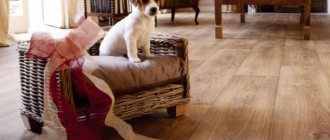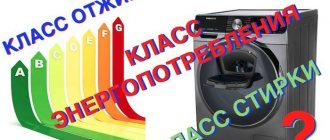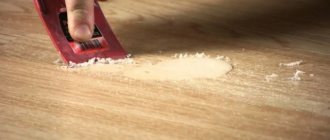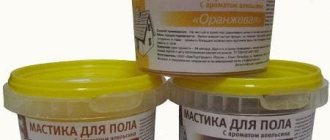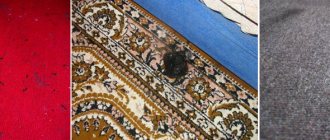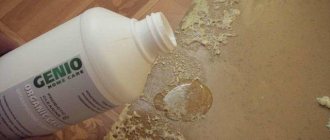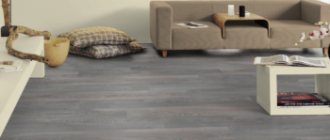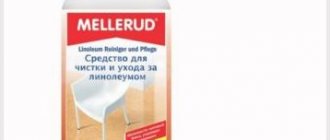Having a good understanding of the classes, you can ideally choose the flooring for the conditions of a particular room (premises) and save a lot of money.
Classification of linoleums according to the indicator “abrasion”
Abrasion is the resistance of the front protective layer of linoleum to abrasion (resistance to abrasive effects on the surface). This parameter is checked using a special test on high-precision equipment.
Linoleum is subjected to abrasive action (dosed) under standard conditions. The entire procedure is regulated by the EN660-1 standard. After testing, one of four markings is applied to the material.
“T” is a group of durable and reliable coatings that practically do not wear out. This type of coating is used in the production of industrial linoleum. The price is very high, so they are rarely used. During testing, changes in layer thickness amounted to 0.08 mm.
“P” is a group of low-abrasion coatings. Used for the production of linoleum, which is subject to large dynamic and static loads. It can be used in industry if heavy equipment will not move on the surface of such a coating. During testing, changes in layer thickness amounted to 0.15 mm.
“M” is linoleum with a moderately abraded coating. A more appropriate phrase here is “ideal value for money.” This option is ideal for both offices and home. During testing, changes in layer thickness amounted to 0.3 mm.
“F” - This group of highly abraded linoleums. They should be used in places with little traffic. Ideal for bedroom, hall. Lowest price for material. During testing, changes in layer thickness amounted to 0.6 mm.
Features of the protective layer
Differences in linoleum are determined not only by alphabetical markings; there are additional indicators in the form of icons. In most cases, the marking contains a corresponding picture:
- antistatic coating - for rooms with a large number of operating equipment;
- high noise insulation - for a concrete base or the first floors of a structure;
- antibacterial - this protective layer of linoleum for the kitchen will be optimal, it is also suitable for a child’s room, honey. institutions;
- anti-slip – for areas where frequent wet cleaning is carried out;
- double base - means that the product has the best heat and sound insulation qualities;
- fireproof coating.
If we are talking about a canvas that can be placed in the kitchen, you should pay attention to such a factor as the varnished layer. This additional protection guarantees increased service life, reduced wear, and prevention of scratches. Another method of increasing the strength of the flooring material is embossing, and it is possible to create a pattern simulating stone, tile, or wood.
Classification of linoleums by wear resistance
Wear resistance is the ability of the linoleum surface to resist constant mechanical loads.
Attention!!! The concepts of abrasion and wear resistance are not the same. Because “T” class linoleum will not be inferior in strength to “M” class linoleum if it has a thick protective layer.
To understand wear resistance classes, you should refer to the unified European classification EN 685, which was adopted in December 1995. This classification includes all types of flooring (parquet, laminate, ceramic tiles). This is very convenient because it allows you to compare different finishing materials according to two parameters: load intensity and type of room.
This means that each material model is assigned a two-digit number. The first number is responsible for the type of room, and the second is responsible for the wear resistance of the front layer. The manufacturer first carries out all the required tests, and only after that a class is assigned to the linoleum.
Now we will consider each parameter separately and in more detail.
Wear resistance or the level of load that a surface can withstand:
- Low load level.
- Average load.
- High or intense workload.
- Extreme or very high load.
Room type or application class
The number “2” denotes household linoleum . This category includes all floor coverings that have a picture of a house on the packaging.
The advantages of this category include:
- Lowest cost.
- The material is pleasant to the touch, pleasant to walk barefoot.
- Good thermal insulation.
- High selection of textures and patterns.
- Environmentally friendly material, confirmed by hygienic certificates.
The thickness of the protective layer of household linoleum lies in the range of 0.1-0.35 mm, with a total product thickness of 1.5-5 mm. As for the service life, it is about 5 years.
Class 21 - soft linoleum, it is advisable to install it in places with little traffic - bedrooms, closets and closets.
Class 22 - linoleum, which can be exposed to average dynamic and static loads. They are widely used in children's rooms, halls and bedrooms.
Class 23 is the most common and popular product from this group. Placed in places with high dynamic load, such as corridors, halls.
You should pay attention to the products of the following manufacturers: Utex, Sinteros and Tarkett. The average price for 1 square meter is 200-300 rubles.
The number "3" denotes commercial linoleum . But sometimes it is also called “Office”. The packaging of this product shows an office building. The service life of these linoleums is about 15 years.
The advantages of this category include:
- The variety of textures, colors and patterns is less than that of household ones, but there is quite a large selection.
- Increased wear resistance.
- Dense structure.
The thickness of the protective layer of commercial linoleum is in the range of 0.3-0.6 mm. As the name suggests, it is widely used in offices, public places, and, more recently, in residential buildings.
Class 31 - used in bosses' offices, where there is little traffic, hotel rooms, in the kitchen and in corridors.
Class 32 – used for flooring in shops, reception areas, kindergartens. Where there is an average dynamic and static load on the surface. It is in great demand among ordinary people, since for reasonable money you get high-quality linoleum.
Class 33 - high-strength linoleum is ideal for offices with high traffic. The manufacturer provides a guarantee for the material for 10-15 years.
Class 34 is the most reliable and durable linoleum of this class. Used in critical places such as hypermarkets, airports, train stations.
The cost of one square meter of production is approximately 300-400 rubles.
The number “4” denotes industrial linoleum . The packaging of this group of materials shows the plant. It should be said right away that this type of coating is used only in industry, rarely for commercial purposes. Due to increased requirements for the material, the choice of colors is limited. Service life is at least 10 years. The thickness of the protective layer starts from 0.6 mm. The main disadvantage is the very high cost.
Class 41 - this type of linoleum is used in production for floors mainly for sedentary work. For example, a workshop, quality control department (technical control department), repair areas, and so on.
Class 42 - can be used in almost any industrial premises where special equipment is not used.
Class 43 is the most durable and reliable type of linoleum. Used in rooms with heavy traffic of people and special equipment.
Due to its high cost, it is rare on sale. Approximate cost per 1 sq.m. is about 1000-1500 rubles.
Nitrocellulose or colloxelin
It is produced on the basis of nitrocellulose, which provides such excellent properties as gloss, high elasticity, and moisture resistance. It is a baseless, single-layer coating with high moisture resistance and elasticity. Since this type has high flammability rates, it is not used in educational institutions, children's institutions, residential buildings, outdoors and at temperatures above +40 °C and below -10 °C. Colloxyline flooring can only be found in office premises.
The above characteristics of linoleum are enough to select a safe material suitable for the expected load in a particular room. Pay attention to the labeling when purchasing.
Specialized classification of linoleums
On the reverse side of linoleum, in addition to the above classifications, the following classes must also be present: smoke generation, flammability, flammability and flame distribution.
The safety of people directly depends on these parameters. All approvals can be viewed here - GOST 30402.
Flammability is indicated by the letter “G” and shows what danger the material poses during combustion. There are 4 groups.
“G1” is a group of slightly flammable materials. Almost all linoleums belong to this group. At a temperature of 135 degrees Celsius, the first off-gases appear, and the material changes mass by at least 65%. And the main thing is that the material itself does not burn.
“G2” is a group of slightly flammable materials. Rubber and cellulose linoleums are suitable here. The characteristics are similar, but the material supports combustion, but not more than 30 seconds.
“G3” and “G4” - there are no linoleums in these groups. But it is not recommended to buy this product. These classes burn easily and support this process.
Flammability is indicated by the letter “B”. Here, the larger the number behind the letter “B”, the worse the material.
Smoke production is indicated by the letter “D”; the lower the number, the better. There are only three number options.
The flame distribution is designated by the letters “RP”, and then by analogy, the lower the number, the better.
Pros and cons of flooring
Linoleum has the following advantages:
- Low cost;
- Resistant to humid environments and steam;
- Wear-resistant. Tolerates physical activity well;
- Does not require a protective film, since it is already included in the product;
- Slip-resistant. Even those types that have a glossy surface;
- Can be connected to a heated floor system due to the ability to lay the product on a substrate;
- Variety of designs, colors. Can be matched to any interior;
- Easy to care for. No special cleaning products required.
When doing renovations, you should take the choice of flooring as seriously as possible.
But the coating also has disadvantages. Among them:
- Most products have an artificial composition. Due to non-natural components, the canvas has a specific odor;
- It is difficult to remove marks from shoes with black soles;
- A flat surface is required for installation.
If you decide on linoleum, know that there are several types of it, different in characteristics depending on the purpose of the room in which it will be used.
Kinds
The range of semi-commercial linoleum is varied. Trademarks offer different options for sale that can satisfy any customer preferences. The most popular types of floor coverings include:
- antistatic;
- fire protection;
- insulated;
- with 3D effect;
- with anti-slip protection.
Based on the type of base, the material is divided into two types:
- on a felt basis;
- on a foam basis.
Each type has its own characteristics and is designed for a specific type of room. Semi-commercial flooring is divided into two types: heterogeneous (multilayer) and homogeneous type.
A heterogeneous class of material consists of several components:
- protective, protecting the coating from abrasion;
- finishing, giving the coating an original pattern;
- the basis for the drawing, thanks to which the pattern is held;
- fiberglass, eliminating deformation and increasing strength;
- foam base necessary for heat and sound insulation;
- a layer of marking indicating affiliation with a specific brand.
The homogeneous class of semi-commercial linoleum is distinguished by the presence of a single layer with a uniform structure. In addition, the material is characterized by a relatively large weight compared to its heterogeneous counterpart. The disadvantage of the coating is that it is not as attractive as a heterogeneous coating: its aesthetic characteristics leave much to be desired. It also does not have a protective layer, which is a significant disadvantage.
